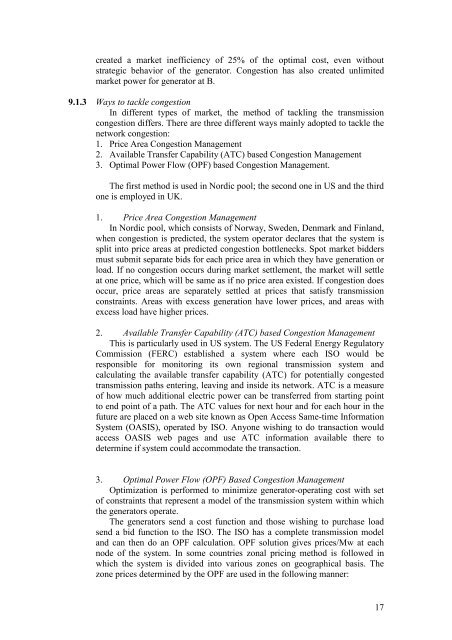Introduction to Deregulation in Power Industry - nptel
Introduction to Deregulation in Power Industry - nptel
Introduction to Deregulation in Power Industry - nptel
Create successful ePaper yourself
Turn your PDF publications into a flip-book with our unique Google optimized e-Paper software.
created a market <strong>in</strong>efficiency of 25% of the optimal cost, even without<br />
strategic behavior of the genera<strong>to</strong>r. Congestion has also created unlimited<br />
market power for genera<strong>to</strong>r at B.<br />
9.1.3 Ways <strong>to</strong> tackle congestion<br />
In different types of market, the method of tackl<strong>in</strong>g the transmission<br />
congestion differs. There are three different ways ma<strong>in</strong>ly adopted <strong>to</strong> tackle the<br />
network congestion:<br />
1. Price Area Congestion Management<br />
2. Available Transfer Capability (ATC) based Congestion Management<br />
3. Optimal <strong>Power</strong> Flow (OPF) based Congestion Management.<br />
The first method is used <strong>in</strong> Nordic pool; the second one <strong>in</strong> US and the third<br />
one is employed <strong>in</strong> UK.<br />
1. Price Area Congestion Management<br />
In Nordic pool, which consists of Norway, Sweden, Denmark and F<strong>in</strong>land,<br />
when congestion is predicted, the system opera<strong>to</strong>r declares that the system is<br />
split <strong>in</strong><strong>to</strong> price areas at predicted congestion bottlenecks. Spot market bidders<br />
must submit separate bids for each price area <strong>in</strong> which they have generation or<br />
load. If no congestion occurs dur<strong>in</strong>g market settlement, the market will settle<br />
at one price, which will be same as if no price area existed. If congestion does<br />
occur, price areas are separately settled at prices that satisfy transmission<br />
constra<strong>in</strong>ts. Areas with excess generation have lower prices, and areas with<br />
excess load have higher prices.<br />
2. Available Transfer Capability (ATC) based Congestion Management<br />
This is particularly used <strong>in</strong> US system. The US Federal Energy Regula<strong>to</strong>ry<br />
Commission (FERC) established a system where each ISO would be<br />
responsible for moni<strong>to</strong>r<strong>in</strong>g its own regional transmission system and<br />
calculat<strong>in</strong>g the available transfer capability (ATC) for potentially congested<br />
transmission paths enter<strong>in</strong>g, leav<strong>in</strong>g and <strong>in</strong>side its network. ATC is a measure<br />
of how much additional electric power can be transferred from start<strong>in</strong>g po<strong>in</strong>t<br />
<strong>to</strong> end po<strong>in</strong>t of a path. The ATC values for next hour and for each hour <strong>in</strong> the<br />
future are placed on a web site known as Open Access Same-time Information<br />
System (OASIS), operated by ISO. Anyone wish<strong>in</strong>g <strong>to</strong> do transaction would<br />
access OASIS web pages and use ATC <strong>in</strong>formation available there <strong>to</strong><br />
determ<strong>in</strong>e if system could accommodate the transaction.<br />
3. Optimal <strong>Power</strong> Flow (OPF) Based Congestion Management<br />
Optimization is performed <strong>to</strong> m<strong>in</strong>imize genera<strong>to</strong>r-operat<strong>in</strong>g cost with set<br />
of constra<strong>in</strong>ts that represent a model of the transmission system with<strong>in</strong> which<br />
the genera<strong>to</strong>rs operate.<br />
The genera<strong>to</strong>rs send a cost function and those wish<strong>in</strong>g <strong>to</strong> purchase load<br />
send a bid function <strong>to</strong> the ISO. The ISO has a complete transmission model<br />
and can then do an OPF calculation. OPF solution gives prices/Mw at each<br />
node of the system. In some countries zonal pric<strong>in</strong>g method is followed <strong>in</strong><br />
which the system is divided <strong>in</strong><strong>to</strong> various zones on geographical basis. The<br />
zone prices determ<strong>in</strong>ed by the OPF are used <strong>in</strong> the follow<strong>in</strong>g manner:<br />
17
















